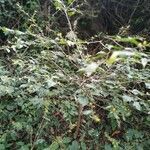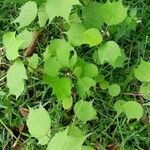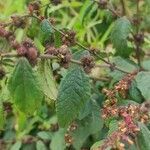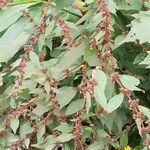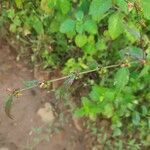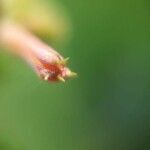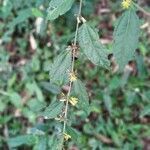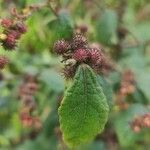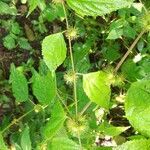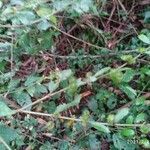Very polymorphic species up to about 2 m tall, usually annual but there seem to be perennial forms; branches almost glabrous to velvety or tomentose. Leaf-blade 25-150 x 20-100 mm, ovate to ovate-lanceolate, acute at the apex, often three-lobed, cordate or truncate at the base, 3-7-nerved from the base, irregularly serrate; petiole up to 50 mm long; stipules about 4 mm long, linear-lanceolate, setose-pubescent. Inflorescence foliose with the inflorescence leaves smaller and narrower than the cauline leaves; cymes crowded at the nodes; peduncles and pedicels short, 1.5-3 mm long; bracts linear, about 3 mm long, pubescent. Sepals 4-5 mm long, linear, hooded towards the apex, stellate-pubescent outside or almost glabrous; subapical hom about 0.5 mm long, setulose-pubescent. Petals yellow, slightly shorter than the sepals, linear-oblanceolate, villous at the base. Androgynophore 0.25 mm tall with suborbicular glands opposite the petal bases; annulus villous on its upper margin. Stamens about 15. Ovary 2-3-locular, closely setulose or echinulate. Capsule 4-5 mm in diam. including the prickles, globose or ovoid-globose, its body densely tomentose; pricles uncinated at the apex, glabrous.
Herbs, annual. Stems erect, branched, 3–18 dm, stellate-pubescent to glabrate. Leaves: petiole 1–5(–7) cm; proximal blades broadly ovate-orbiculate, rhombic, elliptic, or broadly ovate, usually palmately 3-lobed, 3–9(–15) cm, distal ovate to ovate-lanceolate or oblong-lanceolate, not lobed, base broadly cuneate or rounded to cordate or truncate, margins irregularly serrate, apex acute, surfaces: abaxial densely stellate-pubescent, adaxially sparsely stellate-pubescent, 3–5-veined from base. Inflorescences 3–5(–6) per axil, often subspicate; peduncle 1–3 mm. Pedicels 0.5–2 mm. Flowers: sepals narrowly oblong to linear-oblong, subapically appendaged, 4–5.5 mm, stellate abaxially; stamens 10–15; ovaries 3–4-locular. Capsules globose to ovoid-globose, 2.5–3 mm, surface densely tomentose-pilose; spines uncinate, glabrate, sparsely and minutely stipitate-glandular. 2n = 32.
Subshrubs or herbs. Branchlets gray-brown tomentose. Petiole 1-5 cm; lower leaf blades broadly ovate-orbicular, rhomboid, or broadly ovate, 3-lobed, 3-9.5 × 2-8.5 cm, abaxially stellate pilose, adaxially sparsely hairy, basal veins 3-5, 2 lateral ones reaching tip of lobes, base broadly cuneate or rounded, margin irregularly bluntly serrate, apex acute; upper leaf blades oblong-lanceolate, not lobed. Cymes 3-5 per axil; peduncle to 2 mm. Flower buds cylindrical, apex slightly wider, ca. 4 mm. Pedicel less than 1 mm. Sepals narrowly oblong, 4.5-5.5 mm, villous, appendaged at tip. Petals yellow, slightly shorter than sepals, hairy along margins. Stamens 10. Ovary spiny. Capsule globose, ca. 3 mm in diam., spiny, indehiscent; spines ca. 2 mm, gray-yellow puberulent, tip hooked. Seeds 2-6. Fl. summer-autumn. 2n = 32.
Polymorphic, annual herb or occasional perennial shrub, 0.01-2.00 m high. Leaves lanceolate, ovate or rhombic, often 3-lobed, apex acute, base cuneate to cordate, 3-7-nerved from base, margins irregularly serrate. Inflorescences foliolate, cymes crowded at nodes; peduncles and pedicels up to 3 mm long; bracts linear, ± 3 mm long, pubescent. Flowers 4-5 mm long, yellow. Sepals linear, hooded towards apex. Petals slightly shorter than sepals, linear-oblanceolate. Androgynophore ± 0.25 mm long, annulus villous on upper margin. Flowering time Sept.-Apr. Fruit a globose capsule, body densely tomentose, prickles uncinate.
A herb or small shrub. It keeps growing from year to year. Plants can be 1.5 m high. The bark is tough and fibrous. The younger stems and leaves and flowers are covered densely with hairs. The leaves are alternate and the edges of the leaves have teeth. The lower leaves have 3 lobes. The flowers occur in small clusters opposite the axils of leaves. The stalks carrying the flowers are 20-40 cm long. There are 5 yellow petals. The fruit are brown and hairy and covered with hooked spines. The fruit are round and about 5 mm across. They contain 2-4 seeds. The fruit cling to clothing.
Leaf-lamina 2·5–15 × 2–10 cm., ovate to ovate-lanceolate, acute at the apex, often 3-lobed, cordate or truncate at the base, 3–7-nerved from the base, irregularly serrate; petiole up to 5 cm. long; stipules c. 4 mm. long, linear-lanceolate, setose-pubescent.
Inflorescences leafy, with the inflorescence leaves smaller and narrower than the cauline ones; cymes crowded at the nodes; peduncles of cymes and pedicels short, 1·5–3 mm. long; bracts c. 3 mm. long, linear, pubescent.
Annual or perennial herb, 2 m high. Leaves broadly ovate to ovate-lanceolate, often 3-lobed, obtuse to rounded at base. Prickles on fruit uncinate at apex, hooked or falcate, glabrous. Flowers yellow.
Sepals 4–5 mm. long, linear, hooded towards the apex, stellate-pubescent outside or almost glabrous; subapical horn c. 0·5 mm. long, setulose-pubescent.
Fruit 4–5 mm. in diam. including the aculei, globose or ovoid-globose, its body densely tomentose; aculei uncinate at the apex, glabrous.
Petals yellow, slightly shorter than the sepals, linear-oblanceolate, villous at the base.
Androgynophore 0·25 mm. tall with circular glands: annulus villous on its upper margin.
Very polymorphic species, usually annual but there seem to be perennial forms.
Stems almost glabrous to velvety or tomentose, up to c. 2 m. tall.
Ovary 2–3-locular, closely setulose or echinulate.
A weedy undershrub, variable in habit and foliage
Flowers orange or yellow.
Stamens c. 15.
